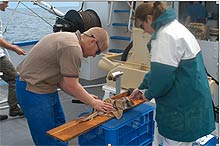Interview with a shark scientist
Kate Rodda, Senior Research Scientist
Kate is employed at the South Australian Research and Development Institute (SARDI).
1. How long have you worked at your current place of employment?
12 years.
2. Have you always been a shark biologist?
No, I started working on sharks during my PhD studies working on shark embryos. I then worked on abalone for 10 years. During these 10 years I did some work on white sharks. For the last 2 years I have been full time on sharks, skates and stingrays in Spencer Gulf, South Australia.
3. How did you become a shark biologist?
My PhD studies introduced me to the world of sharks, although I have been an active diver for many years and have always had an interest in marine animals, especially sharks. I gave my first official shark talk to a group of fellow school mates when I was 12 years old.
|

Port-Jackson shark
Image © Ken Hoppen Photography
|
4. Why did you become a shark biologist?
I always wanted to work with sharks in one way or another, I was always fascinated by their behaviours both in the wild and in captivity and wanted to help change public attitudes in order to conserve and protect the dwindling populations around the world.
5. What shark/s do you work with?
I work with white sharks, Port Jackson sharks and many other species that are found in the Spencer Gulf, SA.
6. What are you trying to find out about the sharks?
My study is examining general population parameters of these sharks, such as growth, movement, when they breed, how they breed, what they eat etc.
7. Have you ever been bitten by a shark?
I have been bitten by juvenile Port Jackson sharks, but they don't hurt much because they have grinding teeth, not sharp teeth. I wouldn't like to have my hand in an adults mouth though because they can crush bones!
8. What's the biggest shark you have ever seen?
The largest shark I have seen was a 5.3 m white shark (17 ft). She was caught a few years ago in Port Pirie and I helped dissect her.
|

Jeremy and I measuring
and
tagging a small Port Jackson shark
.
Image © Kate Rodda |
9. Have you ever been diving in a shark cage?
Yes, I have been on white shark trips where we have tagged sharks with a variety of tags. This involved going into the cage and getting more information about the animals tagged. For instance, sometimes you can’t tell if it’s a male or female until you see it in the water. You can also get a good idea of distinguishing marks that the shark has from in the water.
10a. What's the best part about your job?
Observing live sharks swimming in their natural habitat and finding out new information about them.
10b. Worst part?
Although a necessary part of research, the actual dissections can be a negative. I would rather see the shark swimming around.

|
